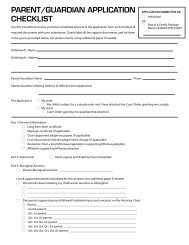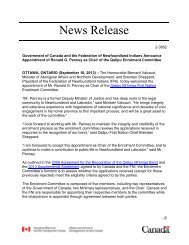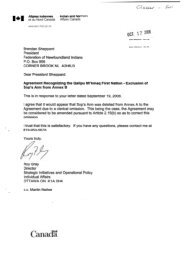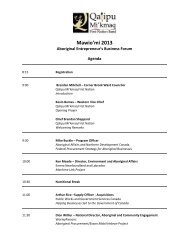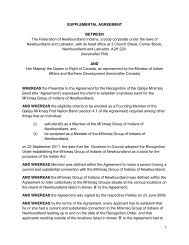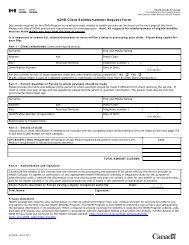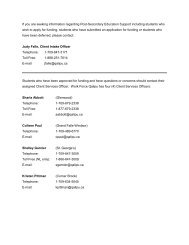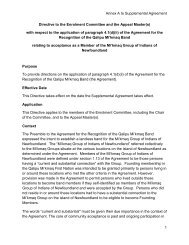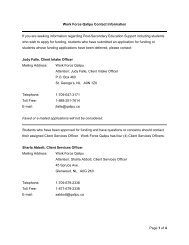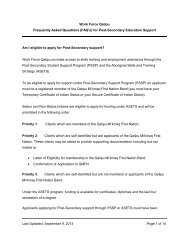FNI Elder Stories and Profiles - Qalipu Mi'kmaq - First Nation Band
FNI Elder Stories and Profiles - Qalipu Mi'kmaq - First Nation Band
FNI Elder Stories and Profiles - Qalipu Mi'kmaq - First Nation Band
Create successful ePaper yourself
Turn your PDF publications into a flip-book with our unique Google optimized e-Paper software.
<strong>FNI</strong> <strong>Elder</strong> <strong>Stories</strong> <strong>and</strong> <strong>Profiles</strong>collected from various sources
ELDER PROFILES TABLE OF CONTENTSCorner Brook Indian B<strong>and</strong>Elmastogoeg (Benoit’s Cove) Indian B<strong>and</strong>Flat Bay Indian B<strong>and</strong>Glenwood Mi’Kmaq <strong>First</strong> <strong>Nation</strong>sIndian Head <strong>First</strong> <strong>Nation</strong>sPort au Port Indian B<strong>and</strong>Sple’tk (Exploits) Indian B<strong>and</strong>St. George’s Indian B<strong>and</strong>Miawpukek <strong>First</strong> <strong>Nation</strong>OtherDuhart, HubertEdmunds, Acting-Chief ElliePike, PaulBarnes, Chief KevinCompagnon, ValmoreR<strong>and</strong>ell, Annie M. (McCarthy)Rumbolt, PatSams, WilliamVincent, ArthurWoods, DonaldAlex<strong>and</strong>er, DormanSheppard, BrendanWebb, MaryWhite, DannyJeddore, Chief LarryJohn, TonyVaters, MarieRussell, FrankMacDonald, Chief Laetitia (Litty)Beaton, GeraldHopfel, MargaretHumber, KathleenMills, TerryPaul, Ignatius (Nish)Power, Chief NellieBenoit, AnselmBenoit-Dawson, Chief VioletMuise, Victor James, Jr.Skinner, HowardSpicer, JosephineJohn, MarilynMitchell, Mattie
ELDER PROFILES: Corner Brook Indian B<strong>and</strong>Hubert Duhart (July 1, 1922-), 2005Mr. Duhart is one of the most highly respected <strong>and</strong> honoured elders on the Corner BrookIndian B<strong>and</strong>. Hubert was born July 1, 1922 in Corner Brook, NL to Timothy Duhart <strong>and</strong> LucyEllen Mitchell, the daughter of well known Aboriginal guide, Mattie Mitchell. He graduatedhigh school in 1938 <strong>and</strong> took a position a short time later with the Bowater Paper Company,an eleven year old business in the Corner Brook area.In 1945 Mr. Duhart changed horses in mid stream when he took a position with the NfldCustoms company which was transferred to Customs <strong>and</strong> Excise Canada. Starting in 1952 hetook an appraisal course <strong>and</strong> was appointed Customs Appraiser. In 1957 Hubert participatedin an office management course <strong>and</strong> became Collector of Customs in 1962. In 1968 hegraduated from a course in instructional techniques <strong>and</strong> in 1971 participated in a coursemanagement development . Following this, in 1972, Hubert graduated from the DrugEnforcement course offered by the RCMP <strong>and</strong> in the same year became Area manager forCustoms excise Canada on the West Coast of NL. He retired his position from that governmentdepartment in 1980 with 35 years of grateful service.Mr. Duhart is the father of six children; Brenda, Ona, Darrell, Wayne, Myra <strong>and</strong> Anthony. Theyare very proud of their father’s acomplishements. Hubert recently celebrated his 62nd Anniversaryto his beautiful wife Mary (Quann) Durhart <strong>and</strong> I hope this couple celebrate manymore. I am indeed proud <strong>and</strong> honoured to call this man <strong>and</strong> his family “friends”.Submitted by Acting Chief Ed Webb, April 27, 2005
ELDER PROFILES: Corner Brook Indian B<strong>and</strong>Acting-Chief Ellie Edmonds, 2003I have served as Acting-Chief of the Corner Brook Indian B<strong>and</strong> Council for the past year. I have meta lot of interesting people <strong>and</strong> learned a lot about our culture.I grew up being very aware of my Mi’kmaq ancestry. Going fishing <strong>and</strong> hunting with my dad <strong>and</strong>uncle <strong>and</strong> learning the ways of the l<strong>and</strong>. As a young child I remember being made fun of <strong>and</strong> calleda savage because we were Mi’kmaq. Now people are coming out of the woodwork trying to provetheir Mi’kmaq ancestry.From the exhibition, “The Mi’kmaw People of Newfoundl<strong>and</strong>: A Celebration.”
ELDER PROFILES: Corner Brook Indian B<strong>and</strong>Paul Pike, 2004Paul Pike is a Mi’kmaq man from Corner Brook, NL, who now lives in Alaska, <strong>and</strong> is carrying onthe Mi’kmaq culture as a pipe carrier.Kwe’ Nokamaq,I would like to say that it was such an honor to see so many of our people joining in our culturalactivities this year. I almost cried watching you dance <strong>and</strong> share your stories. Some of you cameout to the Pipe Ceremony for the Unity of our people in Corner Brook in July <strong>and</strong> I had the privilegeto pray with you also. Even though I am thous<strong>and</strong>s of miles away in Alaska, I am always trying tostay in touch <strong>and</strong> keep up to date on what’s happening with our Ktaqmkuk Mi’kmaq People.I am very proud to tell our story through traditional <strong>and</strong> contemporary songs with my b<strong>and</strong>Medicine Dream (www.medicinedream.com). Many people of many cultures around the worldnow know who we are on this Isl<strong>and</strong> <strong>and</strong> about the injustices <strong>and</strong> sl<strong>and</strong>erous stories told about usby colonial goverments. People know that we are a peaceful loving people.This summer I had the honor of working with the Peabody Essex Museum in Salem, Massachusettsidentifying Mi’kmaq artifacts in their collection <strong>and</strong> describing how they were made. I alsorecorded some of my own traditionally inspired songs. Just recently, Medicine Dream performedat the Kennedy Center in Washington D.C. as part of a multi-cultural celebration. We performed infront of about 34,000 people <strong>and</strong> they got to hear about our Mi’kmaq way of life on the Isl<strong>and</strong>.Good things are happening <strong>and</strong> all of you are a part of it. My prayers go out to you all.Welalioq aqq nmu’ltes app, Msit Nokamaq,Paul Pike (Ketupekiet Sisip - Singing Bird)From <strong>FNI</strong>’s MI’kmaq News: Fall 2004
ELDER PROFILES: Elmastogoeg (Benoit’s Cove) Indian B<strong>and</strong>Chief Kevin Barnes, 2003It was not until recent years <strong>and</strong> through genealogy research that I have come to know withcertainty my Mi’kmaq ancestry. Growing up this ancestry was not discussed openly <strong>and</strong> the subjectmasterfully avoided by my gr<strong>and</strong>mother. Oftentimes there were comments <strong>and</strong> even accusationsabout the existence of Indians on my gr<strong>and</strong>mother’s side, but the inquisitive mind of a child waseasily suppressed <strong>and</strong> fears alleviated by her frank denial.Although many of us did not readily identify as having aboriginal roots, the customs <strong>and</strong> valuesthat are documented to be part of the Mi’kmaq culture remained strong throughout thegenerations <strong>and</strong> make us who we are today. Hunting, fishing <strong>and</strong> gathering berries continue tobe a necessary part of many families’ lives. With the arrival of the Europeans, the aboriginals tookon aspects of the European life style therefore diluting their own. However, that does not make theMi’Kmaq people none the less Mi’Kmaq.Today with the renewal of the Newfoundl<strong>and</strong> Aboriginal culture, I am pleased <strong>and</strong> proud to saythat I am part of that culture. As I research <strong>and</strong> learn more about Mi’Kmaq culture I come to therealization that this is the culture of a very unique people. Daniel N. Paul, Mi’Kmaq author,describes the pre-European Mi’kmaq culture as a well-developed society founded upon threeprinciples: the supremacy of the Great Spirit, respect for Mother Earth <strong>and</strong> the equality of allpeople. The absence of hierarchical differences is one of the best indicators of the advancedMi’Kmaq human development in which all people were accepted as equals. This is an ideal whichmodern society is still working toward.I hope that with the heightened interest in the Mi’Kmaq culture comes a better underst<strong>and</strong>ingof the true values <strong>and</strong> beliefs of its people <strong>and</strong> the stereotypes that are now dominant becomesomewhat lessened.From the exhibition, “The Mi’kmaw People of Newfoundl<strong>and</strong>: A Celebration.”
ELDER PROFILES: Elmastogoeg (Benoit’s Cove) Indian B<strong>and</strong>Valmour Compagnon, 2003Taking our living from the l<strong>and</strong> was a way of life for my family. Hunting, fishing, gathering berries<strong>and</strong> wood was a means of survival. Many of the remedies used for the treatment of aliments <strong>and</strong>injuries came from the l<strong>and</strong>. Some of the traditions of our ancestors still remain today.Times were hard <strong>and</strong> we all worked hard <strong>and</strong> didn’t have much. But what we did have was a greatrespect for the l<strong>and</strong> <strong>and</strong> for each other. There was a great sense of family <strong>and</strong> community <strong>and</strong> allwere willing to lend a h<strong>and</strong> to a neighbor, a friend or a family member in need.I would like to see the Mi’kmaq people in Newfoundl<strong>and</strong> receive the recognition that has beendenied them for so many years.From the exhibition, “The Mi’kmaw People of Newfoundl<strong>and</strong>: A Celebration.”
ELDER PROFILES: Elmastogoeg (Benoit’s Cove) Indian B<strong>and</strong>Annie M. R<strong>and</strong>all (McCarthy), 2003I have been a member of the Benoit’s Cove Indian B<strong>and</strong> Council since 1981. Prior to this period oftime I wasn’t aware of my aboriginal ancestry as many individuals in NL. One of the greatest keptsecrets in Canadian History is that there are Indians in Newfoundl<strong>and</strong>. The majority of my activityas a Mi’kmaq person has been through my employment as the Executive Assistant of theFederation of Newfoundl<strong>and</strong> Indians. I was hired in 1988 <strong>and</strong> have worked with the organizationsince that time.The contribution that I personally feel that I have made to the Mi’kmaq advancement inNewfoundl<strong>and</strong> is actively pursuing programs <strong>and</strong> services with the executive <strong>and</strong> board ofdirectors for our people. For each individual that the <strong>FNI</strong> has assisted in completing their education<strong>and</strong> obtaining employment has started not only an individual on the right track to a better life butan entire family; because chances are that every youth we are assisting today will someday have afamily. Each time this is done “I feel great about what we as the <strong>FNI</strong> are doing.”This exhibition is long overdue. But its great to know that so many of our people are eager toexpose themselves for who they truly are “Mi’kmaq people of Newfoundl<strong>and</strong>.” The injustice thatwas done in 1949 will no longer be a secret.From the exhibition, “The Mi’kmaw People of Newfoundl<strong>and</strong>: A Celebration.”
ELDER PROFILES: Elmastogoeg (Benoit’s Cove) Indian B<strong>and</strong>Pat RumboltElmastogoeg <strong>First</strong> <strong>Nation</strong>s has developed much more than how to become a member, withmany thanks to Pat Rumbolt we have achieved so much....Mr. Rumbolt was one of thosepeople who tried to make more out of everything each day; he was an exceptional humanbeing. Mr. Rumbolt travelled the country to learn the Mi’kmaq culture <strong>and</strong> to find out howother b<strong>and</strong>s work. Mr. Rumbolt worked to bring housing to aboriginal persons, as well hebrought programs to help people get trades <strong>and</strong> further their education. And aside from thishe also made projects available to members of Elmastogoeg <strong>First</strong> <strong>Nation</strong>s. Mr. Rumbolt hasdeceased <strong>and</strong> to honor him <strong>and</strong> his hard work <strong>and</strong> dedication, Elmastogoeg <strong>First</strong> <strong>Nation</strong>soffers two scholarships in memory of him, entitled The Pat Rumbolt Memorial Scholarship.<strong>First</strong> <strong>Nation</strong>s still works to accomplish what Mr. Rumbolt worked so hard for, we still offerassistance with regards to funding, projects <strong>and</strong> many other things.Submitted to the <strong>FNI</strong> for their original website.
ELDER PROFILES: Elmastogoeg (Benoit’s Cove) Indian B<strong>and</strong>William SamsElmastogoeg <strong>First</strong> <strong>Nation</strong>s was formed roughly thirty years ago by Wilson Sams. Mr. Sams wasa great leader <strong>and</strong> founder, Elmastogoeg <strong>First</strong> <strong>Nation</strong>s would not be what it is today withouthim. This b<strong>and</strong> council has come a long way since then.To become a member now, government ancestry criteria (birth certificates, census recordsetc) is needed; but this strengthens our b<strong>and</strong> because we learn more about where we camefrom with these records <strong>and</strong> there are plenty of people willing to help others achieve membershipstatus. We all work together to become a stronger b<strong>and</strong>.Submitted to the <strong>FNI</strong> for their original website.
ELDER PROFILES: Elmastogoeg (Benoit’s Cove) Indian B<strong>and</strong>Arthur Vincent, 2003To be Mi’kmaq in 2003 provides me the opportunity to be recognized as a Mi’kmaq person.My great-gr<strong>and</strong>father, father <strong>and</strong> myself have about 150 years of trapping. I trapped with myfather <strong>and</strong> I remember my great gr<strong>and</strong>father. My father took his living from the l<strong>and</strong> <strong>and</strong> sea <strong>and</strong>so did his ancestors.My hopes for the Mi’kmaq is to be recognized by the Federal <strong>and</strong> Provincial governments <strong>and</strong> forthese people to give the Mi’kmaq people back their dignity as all other Mi’kmaq people in thiscountry.I knew my identity was Mi’kmaq but the Federation of Newfoundl<strong>and</strong> Indians brought our cultureto the forefront in lobbying with Federal Government. The work of the <strong>FNI</strong> has done a great jobwith lobbying the Federal Government. Also by the <strong>FNI</strong> finding genealogical funding to assist inrecording our family history on paper.My ancestors came to Newfoundl<strong>and</strong> from Nova Scotia in canoe <strong>and</strong> l<strong>and</strong>ed in S<strong>and</strong>y Point <strong>and</strong>Point Amquil.I had uncles that served in World War I <strong>and</strong> cousins that served in World War II <strong>and</strong> I served in theKorean War. I have two cousins in Basneaw [Bosnia]. They joined to give us our freedom we have today <strong>and</strong> to maintain it.From the exhibition, “The Mi’kmaw People of Newfoundl<strong>and</strong>: A Celebration.”
ELDER PROFILES: Elmastogoeg (Benoit’s Cove) Indian B<strong>and</strong>Donald Woods, 2003Being a Mi’kmaq person in Newfoundl<strong>and</strong> in 2003 means being treated differently than the otherMi’kmaq throughout the rest of Canada. Although it is easily proven that there are many peoplewith Indian background in Newfoundl<strong>and</strong> we are still without our rights.Many of the ways of our every day life are known to be Mi’kmaq. We still depend on the l<strong>and</strong> tomeet our needs. Wild game <strong>and</strong> fish help feed our families. Wild berries are gathered <strong>and</strong> done upin jams for the winter.Being of Indian background is not always easy <strong>and</strong> it is good to see that work is being done to takesome of the stigma away. I would like to see the native people of Newfoundl<strong>and</strong> be seen as equal toother native people in Canada. This would be good for our children <strong>and</strong> gr<strong>and</strong>children.From the exhibition, “The Mi’kmaw People of Newfoundl<strong>and</strong>: A Celebration.”
ELDER PROFILES: Flat Bay Indian B<strong>and</strong>Dorman Alex<strong>and</strong>erDorman Alex<strong>and</strong>er of Flat Bay was only fourteen years old when he first ventured off into theadult world of pulp driving. “There was no such thing as welfare or baby bonus back then,”stated Mr. Alex<strong>and</strong>er. So at his young age he started driving pulp in the rivers <strong>and</strong> ponds inorder to help make ends meet. The work was hard but the living conditions were far worse.They would strip small longers or rungs <strong>and</strong> lay them on the ground with larger logs in between.The logs would divide the sleeping quarters for each man. Small limbs would be cut<strong>and</strong> stuck between the longers to make a softer bed. Each man would have two blankets <strong>and</strong>they would use one to cover the limbs <strong>and</strong> one to cover themselves up. Each year the driveswould take them to different areas but in this particular picture they were on a drive on LadySlipper Road, five miles west of Corner Brook. “We would get the logs into the brook <strong>and</strong>drive them down to Pinchgut Lake, from there we would drive them down Pinchgut River toGeorge’s Lake where Howard’s would boom it up,” states Mr. Alex<strong>and</strong>er. Howard’s was also aloading station for pulp <strong>and</strong> they would load it up on railcars for the trip to Corner Brook. “Wewould take the wood from behind Corner Brook <strong>and</strong> move it further away in order to get it tothe train. Water <strong>and</strong> rail were the cheapest modes of transportation then <strong>and</strong> there wasn’t alot of equipment to make roads back then either,”continues Mr. Alex<strong>and</strong>er. There are still a fewof the men around <strong>and</strong> Mr. Alex<strong>and</strong>er can still recall with detail more of the drives that he wason. “If I told you all the stories I’d keep you here for a long time,” he laughed.Submitted to the <strong>FNI</strong> for their original website.
ELDER PROFILES: Elmastogoeg (Benoit’s Cove) Indian B<strong>and</strong>Brendan Sheppard, 2003I became involved with the aboriginal movement shortly after the inception of the provincialorganization, the Native Association of Newfoundl<strong>and</strong> <strong>and</strong> Labrador in 1971. The provincialorganization was headquartered in St. John’s, NF <strong>and</strong> shortly after they were organized,representatives of the Native Association came into our community because their early researchedresults indicated that there was a well known population of MicMacs (Mi’Kmaq used today) livingin the community of Flat Bay, near St. George’s.As a result of their visit, the community was encouraged to democratically set up a b<strong>and</strong> councilmainly for meeting the requirements to be considered by the federal government for aregistration process sometime in the future, even though the community affairs was historicallymanaged through a cultural <strong>and</strong> traditional process. I was among one of the first b<strong>and</strong> councillorsin the community <strong>and</strong> have since been very active in establishing <strong>and</strong> serving on the variouscommunity committees at the same time promoting <strong>and</strong> carrying out the many different projectsthat benefited the community. A great deal of the community projects came about as a result ofour affiliation with the predecessor of the Federation of Newfoundl<strong>and</strong> Indians, the NativeAssociation of Newfoundl<strong>and</strong> <strong>and</strong> Labrador.At different periods of time since the formation of the Flat Bay Indian B<strong>and</strong> Council in 1972, I servedas councillor, vice-chief <strong>and</strong> chief. The chief’s position provided me the opportunity to serve as adirector at the board table of the Federation of Newfoundl<strong>and</strong> Indians (<strong>FNI</strong>). From the beginningof my involvement with the Flat Bay Indian B<strong>and</strong> Council I had the opportunity to work in severalcapacities with the b<strong>and</strong> <strong>and</strong> as well with the <strong>FNI</strong>, in implementing <strong>and</strong> promoting programs suchas recreation, housing, child care, needs assessment <strong>and</strong> education which brought me to all otherb<strong>and</strong> councils in areas of western Newfoundl<strong>and</strong>.During my involvement with the aboriginal movement I have always maintained a high regard forour culture <strong>and</strong> traditions <strong>and</strong> have endeavored to bring others to a realization of their ancestralroots. I am well respected by my colleagues <strong>and</strong> partners for my strong commitment towardoutst<strong>and</strong>ing accountability <strong>and</strong> fair / equitable treatment for all Mi’Kmaq people ofNewfoundl<strong>and</strong>. I strongly believe that my involvement in the past as well as present was <strong>and</strong> stillis instrumental in assisting the organization move closer to it’s goals <strong>and</strong> objectives in securingFederal recognition for it’s Mi’Kmaq people.
I personally would like to see an agreement in principle signed between the Federation ofNewfoundl<strong>and</strong> Indians <strong>and</strong> the federal department of Indian Affairs which would provide themuch needed programs <strong>and</strong> services, especially economic development which would aid inkeeping our most valuable resource, “our young people” in our own territory.From the exhibition, “The Mi’kmaw People of Newfoundl<strong>and</strong>: A Celebration.”
ELDER PROFILES: Elmastogoeg (Benoit’s Cove) Indian B<strong>and</strong>Mary Webb (1881 - 1978)Mary Webb (neé Francis) was born in the Codroy Valley, where a small b<strong>and</strong> of Mi’kmaq hadtraditionally occupied the area that was granted to the Roman Catholic Church in the early1880s. She later moved to the Mi’kmaq community in Flat Bay, where she married Tom Webb<strong>and</strong> raised a family of nine children as well as five of her gr<strong>and</strong>-children. Mary Webb was amidwife who assisted with the births of more than seven hundred babies, often traveling byhorse <strong>and</strong> sled, dog-team or on snowshoes to reach expecting mothers. A hunter, trapper<strong>and</strong> gatherer of wild foods, she was also knowledgeable in the traditional medicinal uses ofplants. In addition to speaking Mi’kmaq, Mary Webb was fluent in Gaelic, English <strong>and</strong> French.As one of her friends said: “Mary was a kind, gentle lady, highly respected <strong>and</strong> will remain alegendary person in Flat Bay.”From the website: www.nlmikmaq.com
ELDER PROFILES: Elmastogoeg (Benoit’s Cove) Indian B<strong>and</strong>Danny WhiteDanny White is a Mi’kmaq man who has carried on his gr<strong>and</strong>father’s talent of making spruceroot baskets. It is a Mi’kmaq tradition that goes back to our ancestors who used the baskets togather berries or food. Danny has managed to keep his gr<strong>and</strong>father, <strong>and</strong> his father’s memoryalive in the passing on of this Mi’kmaq craft. Since the passing on of his father, Danny is one ofthe only known people in Newfoundl<strong>and</strong> to make baskets of this type. Danny has beenteaching his nephew to carry on the basket making, <strong>and</strong> provided the youth with ademonstration of his work.Submitted to <strong>FNI</strong> by the youth director
ELDER PROFILES: Glenwood Mi’Kmaq <strong>First</strong> <strong>Nation</strong>sChief Larry Jeddore (1922 - 1998)Chief Larry Jeddore was the Chief of the Glenwood Indian B<strong>and</strong> Council <strong>and</strong> a member of theboard of directors of the Federation of Newfoundl<strong>and</strong> Indians (<strong>FNI</strong>) for more than twenty-fiveyears. During these years, he worked tirelessly to obtain federal government recognition ofhis people as status Indians under the terms of Canada’s Indian Act. Chief Jeddore couldhave been recognized as a status Indian after 1984; however, due to his dedication to theFederation of Newfoundl<strong>and</strong> Indians <strong>and</strong> its membership, Chief Jeddore held back in thehope that all the Federation’s members would be recognized. As a result of his efforts onbehalf of the members of the Glenwood Indian B<strong>and</strong> Council, most of the b<strong>and</strong>’s members arenow recognized as Aboriginal people.Even when his health was failing him, Chief Larry Jeddore always attended the Federationof Newfoundl<strong>and</strong> Indians board meetings <strong>and</strong> annual assemblies where his presence <strong>and</strong>prayers for his brothers <strong>and</strong> sisters were always uplifting. Throughout his life, Chief Jeddoreretained his language <strong>and</strong> his Mi’kmaq culture; he was a highly respected role model forAboriginal people. His memory serves as an inspiration to all Newfoundl<strong>and</strong> Mi’kmaq people.From the website: www.nlmikmaq.com
ELDER PROFILES: Glenwood Mi’Kmaq <strong>First</strong> <strong>Nation</strong>sChief Tony John, 2003To be living as a Mi’kmaq person in Newfoundl<strong>and</strong> in 2003, gives me mixed feelings about thesubject. It’s not that I am not proud of being who I am, I am very proud of my aboriginal heritage.It’s the non-recognition by Newfoundl<strong>and</strong> <strong>and</strong> Canada that get my hair up. How convenientit would have been if we were exterminated like our brothers <strong>and</strong> sisters the Beothuck. Then ofcourse, we would get all kinds of recognition, dead recognition. The Government of Canada justrecently announced the rights <strong>and</strong> recognition of the Gay <strong>and</strong> Lesbian couples to be married ascouples, as you can see my point is that gay couples have been given more recognition than theNewfoundl<strong>and</strong> Mi’kmaq.As a small boy, I remember families of Mi’kmaq departing the train station in Glenwood. TheseMi’kmaq families were from Cape Breton, Nova Scotia. They were basket makers <strong>and</strong> sellers.They would stay at gr<strong>and</strong>parents James <strong>and</strong> Helen John. They would come to sell their baskets toAmerican <strong>and</strong> European tourist who came here to fish <strong>and</strong> hunt. These families of the Mi’kmaqspoke fluently in Mi’kmaq <strong>and</strong> carried on many conversations in Mi’kmaq with my gr<strong>and</strong>parents.I spend a considerable amount of time or as much time as I can hunting <strong>and</strong> fishing <strong>and</strong> gatheringfood for my family.The hopes that I have for the Mi’kmaq of Newfoundl<strong>and</strong> is that they will finally be recognized <strong>and</strong>granted all the rights <strong>and</strong> privileges to which they are accorded.Our Mi’kmaq identity was apparent <strong>and</strong> nurtured.I was always told my gr<strong>and</strong>parents <strong>and</strong> parents that the Mi’kmaq were here long before theBeothucks <strong>and</strong> surely before the arrival of any Europeans.My father Gregory John spent four (4) years <strong>and</strong> 264 days in France, Belgium, Germany <strong>and</strong>Holl<strong>and</strong> during World War II. He volunteered, it was his duty.From the exhibition, “The Mi’kmaw People of Newfoundl<strong>and</strong>: A Celebration.”
ELDER PROFILES: Glenwood Mi’Kmaq <strong>First</strong> <strong>Nation</strong>sMarie Vaters, 2003The first meeting of the Native Association of Newfoundl<strong>and</strong> <strong>and</strong> Labrador now known as theFederation of Newfoundl<strong>and</strong> Indians took place at Hotel G<strong>and</strong>er, Newfoundl<strong>and</strong> on February2-4, 1973. I can look back <strong>and</strong> see where history has repeated itself, because my uncle, Greg John,helped to get this organization started <strong>and</strong> today 2003, his son Tony John, Chief of the GlenwoodMi’kmaq <strong>First</strong> <strong>Nation</strong>s along with nine other Mi’kmaq b<strong>and</strong>s represented by the Federation ofNewfoundl<strong>and</strong> Indians still continue to advocate for federal recognition as Indian Act B<strong>and</strong>sor equivalency to Indian Act b<strong>and</strong>s. Even our goals <strong>and</strong> objectives are the same, which is topreserve, promote <strong>and</strong> advance the culture, health, economic, educational <strong>and</strong> social well-beingof our people including our language. Being a Mi’kmaq in 1973 wasn’t as acceptable as it is today.This was just the beginning because prior to this, no one was as vocal in dem<strong>and</strong>ing our rights asaboriginal people, as we are today. We went from being “the savage people” by RichardWhitbourne to being called Indians, then natives <strong>and</strong> now referred to as aboriginal or Mi’kmaq.Today some of the members of the Glenwood Mi’kmaq <strong>First</strong> <strong>Nation</strong>s who have direct relativesliving in Conne River have gained their Indian Status. Through this we have access to Non-InsuredHealth Programs, <strong>and</strong> Post Secondary Education. Even though we have access to those programs,we still have no political gains in terms of other programs <strong>and</strong> services for our communities <strong>and</strong>recognition for our other non-status Mi’kmaq listed with our b<strong>and</strong>, but progress is being made <strong>and</strong>we are being heard. The end result will be something that we as Mi’kmaq people will be proud off,<strong>and</strong> at the end of the day we will not be afraid to say who we are <strong>and</strong> what we st<strong>and</strong> for.My memories consist of my gr<strong>and</strong>parent’s James <strong>and</strong> Helen John, both of who walked from ConneRiver to Glenwood where they settled <strong>and</strong> raised their families. My biggest memories were oflistening to my gr<strong>and</strong>father telling stories about hunting <strong>and</strong> fishing. He would try to get me to saysugar, milk <strong>and</strong> butter in Mi’kmaq but me as a child had no interest. My gr<strong>and</strong>father was a wellknownman who worked guiding on the G<strong>and</strong>er River <strong>and</strong> hunted on the Northwest G<strong>and</strong>erbetween Glenwood <strong>and</strong> Conne River. Many books still exist today with stories written about him.My involvement with the Glenwood Mi’kmaq <strong>First</strong> <strong>Nation</strong>s for the last twenty-five years gaveme lots of memories after working with the Late Chief Larry Jeddore. Chief Jeddore was fluent inMi’kmaq <strong>and</strong> every word he spoke made me proud to st<strong>and</strong> by him at all functions <strong>and</strong> gatheringsover the years. No one was more dedicated to the Mi’kmaq gaining recognition than Chief Jeddore.My hopes are that we will all be treated as equal.
My identity was always part of my awareness. My gr<strong>and</strong>parents were always referred to asIndians. You never really acknowledged your identity when I was growing up, even though youknew, because you were looked down on. I was always aware of my aboriginal ancestry becausewhen I was growing up the people of Conne River were working here <strong>and</strong> many of them lived withmy gr<strong>and</strong>parents <strong>and</strong> my parents, <strong>and</strong> we always had visitors from Nova Scotia that came everyyear selling baskets who would stay at their home. We always knew these people were Mi’kmaqpeople like ourselves.The only thing I remember my gr<strong>and</strong>parents saying about our ancestors was that they were fromConne River. There was never any mention of coming from anywhere other than Conne <strong>and</strong> howthey got here, meaning Glenwood. The only other information came from reading books.My Uncle Greg John fought in World War II. I’m not sure why he joined up. My mother only talkedabout his leaving to go to war <strong>and</strong> his return.From the exhibition, “The Mi’kmaw People of Newfoundl<strong>and</strong>: A Celebration.”
ELDER PROFILES: OtherFrank RussellMi’kmaq poet Frank Russell has been writing seriously for almost ten years. Frank’s poemshave a Mi’kmaq or Newfoundl<strong>and</strong> theme. As an activitist on environmental issues, heoften speaks on his specific concerns for Newfoundl<strong>and</strong> <strong>and</strong> the world at large.As a gifted aboriginal poet, Frank has had offers to have his poems recorded by songcompanies such as Columine Record Corporation USA <strong>and</strong> Country Music USA. Frank’s poem,Honey, was selected for publication by Quill Books of Harlington, Texas. The book of poetryentitiled “Silent Serenade-Volume 1” , was created to promote <strong>and</strong> recognize novicepoets. Closer to home, Frank’s poems are often seen in the DownHomer, the Newfoundl<strong>and</strong>Herald, <strong>and</strong> the Georgian.In 2oo3, he was awarded the title “Mother Earth Guardian” by chiefs of the Bay St. GeorgeB<strong>and</strong> for his demonstrated genuine concern for the earth.From various sources including <strong>FNI</strong>’s MI’kmaq News: Spring 2003.
ELDER PROFILES: Port au Port Indian B<strong>and</strong>Chief Laetitia “Litty” MacDonald, 2003Today I am proud to say that I am Mi’Kmaq. It wasn’t always the case. Growing up if youmentioned the word Indian you were laughed at so you soon learned not to talk about it. Even,at times you might find yourself denying it.If this was the case in my lifetime imagine what it was like for our ancestors. My gr<strong>and</strong>parents havetold about the times they were pelted with rocks <strong>and</strong> called savages, not for anything they haddone but because of who they were.My family have always hunted fished, picked berries <strong>and</strong> used some traditional remedies. Theylived off the l<strong>and</strong> as much as their surroundings allowed. Unfortunately my great-gr<strong>and</strong>motherwho used to go out behind the house to chant <strong>and</strong> pray never passed any customs on to herfamily. It would seem she was afraid to publicly say who she was.Thank God today, because of the relentless efforts of many people, there is a new awarenessof what it means to be Mi’kmaq <strong>and</strong> a pride in being one. I have been a part of the Mi’Kmaqmovement in Newfoundl<strong>and</strong> for the past twenty years. During that time I have worked to promotethe Mi’kmaq culture <strong>and</strong> way of life. I have also worked with others in the hopes of one day gainingthe recognition that has been given to our brothers elsewhere. Currently I serve as Chief of the Portau Port B<strong>and</strong> <strong>and</strong> show by example that we can be proud of whom we are.From the exhibition, “The Mi’kmaw People of Newfoundl<strong>and</strong>: A Celebration.”
ELDER PROFILES: Sple’tk (Exploits) Indian B<strong>and</strong>Gerald Beaton, 2003My name is Gerald Beaton, the son of Rol<strong>and</strong> Beaton <strong>and</strong> the gr<strong>and</strong>son of Mary Paul Beaton.I was born <strong>and</strong> raised in Wigwam Point. This is a well-known documented Micmac hunting <strong>and</strong>fishing place. There is a Micmac gravesite on this l<strong>and</strong>. I recently donated this historic property <strong>and</strong>its deed dated October 6, 1868, to the Sple’tk <strong>First</strong> <strong>Nation</strong>s B<strong>and</strong> where they are going to put anInterpretation Centre focusing on the Mi’Kmaq, Beothuck <strong>and</strong> European peoples. I have lived mylife promoting this site <strong>and</strong> telling of my Micmac heritage. My dream is to see this centre completed<strong>and</strong> bring back all the people who used to come here years ago.From the exhibition, “The Mi’kmaw People of Newfoundl<strong>and</strong>: A Celebration.”
ELDER PROFILES: Sple’tk (Exploits) Indian B<strong>and</strong>Margaret Hopfel, 2003My name is Margaret (John) Hopfel. I am a 76 year old elder with the Exploit’s Indian B<strong>and</strong> in Gr<strong>and</strong>Falls, Newfoundl<strong>and</strong>. I am the daughter of Peter W. John, born in Conne River on December 17,1901. My father could recall stories of when his father, Louis John, was growing up, about his fatherPeter John having contact with the now extinct Beothuck Indians. My father, Peter John couldrecall how his gr<strong>and</strong>father <strong>and</strong> his relatives made moccasins, baskets, <strong>and</strong> snowshoes. As a youngboy my father traveled with his father, gr<strong>and</strong>father <strong>and</strong> uncle, Billy John by canoe <strong>and</strong> camped inwigwams. My father, Peter used to say he remembered how his gr<strong>and</strong>father stood very tall <strong>and</strong> hewas a fine specimen of what the Indian once was belonging to the old type, <strong>and</strong> proud of thetraditions <strong>and</strong> his race. My gr<strong>and</strong>father, Louis John, <strong>and</strong> his brother Billy, <strong>and</strong> his father, Peter Johnwere experienced guides. Most Aboriginal people have enjoyed picking partidgeberries,raspberries, wild strawberries, blueberries <strong>and</strong> bakeapples from natures bountiful gardens overthe years <strong>and</strong> will continue to do so.I remember one time in particular my father went moose hunting <strong>and</strong> no trace of a moose <strong>and</strong> thevery next day a moose walked through the neighbor’s yard next door. I like to thing that there arestill some parts of Newfoundl<strong>and</strong> that are untrodden <strong>and</strong> maybe streams on which a canoe hasnever floated, <strong>and</strong> mountains ranges that have never sent back the echo of a gun. Could there stillbe vast unmapped l<strong>and</strong> over which the herds of caribou could still roam unmolested?From the exhibition, “The Mi’kmaw People of Newfoundl<strong>and</strong>: A Celebration.”
ELDER PROFILES: Sple’tk (Exploits) Indian B<strong>and</strong>Kathleen Humber, 2003I was born Kathleen John, August 22, 1926 here in Gr<strong>and</strong> Falls, Newfoundl<strong>and</strong>. I am the daughterof Louis John, son of Peter John from Conne River. I grew up in Gr<strong>and</strong> Falls <strong>and</strong> lived here all mylife. I am very proud of my father, Louie John, who was a well-known guide, trapper, hunter <strong>and</strong>storyteller. He never believed in hunting for more than you could eat. He would never let any ofhis people he took in the woods kill an animal unless they would agree that if they didn’t want themeat, he could give it to a needy family. My father was also known for making medicine from thetrees, roots <strong>and</strong> berries. The town of Gr<strong>and</strong> Falls-Windsor has named a Nature Preserve in hishonour. I am the youngest <strong>and</strong> sole survivor of fourteen children. I have passed on many stories ofmy past to my six children, thirteen gr<strong>and</strong>children <strong>and</strong> my thirteen great-gr<strong>and</strong>children.I have shared my knowledge with my fellow b<strong>and</strong> members <strong>and</strong> participate in all b<strong>and</strong> activities.I believe that you should share what you know about your past, as this is how our heritage <strong>and</strong>culture will survive.From the exhibition, “The Mi’kmaw People of Newfoundl<strong>and</strong>: A Celebration.”
ELDER PROFILES: Sple’tk (Exploits) Indian B<strong>and</strong>Terry MillsBOTWOOD MAN RECEIVES AQUACULTURE AWARDTerry Mills Has been fish farming for almost 19 years now, but the former well-experiencedcommercial diver had a few hurdles to get over before he got the recognition he deserved.He got the idea for fish farming while he was diving. He decided to start with scallops butsoon realized that he needed another source of income in order to run the day to daybusiness. The growth cycle for scallops was 3-4 years while mussels only had a growth cycleof 18 months. So while he waited for scallops to mature he started with mussels.Of course bad times are all a part of starting up a business <strong>and</strong> Mr. Mills was no exception.At one point he lost 2 million scallops over night. The Arctic ice also caused damage, this wastrying as he had put all his life savings into the business. At a point when most people wouldhave given up, Mr.Mills hung on. His love of living in Newfoundl<strong>and</strong> kept him persevering <strong>and</strong>he was always optimistic about fish farming to help rural Newfoundl<strong>and</strong>ers.His commitment to the industry was rewarded when he was presented with the firstaquaculturist of the year award at the Newfoundl<strong>and</strong> <strong>and</strong> Labrador Aquaculture IndustryAssociation’s annual general meeting.Now Mr. Mills operates two well established businesses on the Isl<strong>and</strong>, Thimble Bay farms <strong>and</strong>Black Gold Incorporated. His farm employs six people with plans to exp<strong>and</strong> to eleven.Information for this story taken with permission of optipress publishing.From <strong>FNI</strong>’s MI’kmaq News: Spring 2003
ELDER PROFILES: Sple’tk (Exploits) Indian B<strong>and</strong>Ignatius “Nish” Paul, 2003My name is Ignatius Paul, son of Frank Paul <strong>and</strong> the gr<strong>and</strong>son of John Paul, who were bothtrappers in the Badger area. I have lived in Badger all my life <strong>and</strong> I am now 65 years of age. WhenI was younger I trapped <strong>and</strong> fished with my father, Frank <strong>and</strong> I continue to do the things that hetaught me. Also, I am still walking in his trails along the banks of the Exploits River where I built ahunting <strong>and</strong> fishing lodge known as Eagle’s Haven Lodge.I pass on my skills to anyone who asks <strong>and</strong> I am willing to share my heritage with others. Beingfrom Badger, my father <strong>and</strong> myself worked on the Badger Drive in the 1960’s as boatsmen. Wealso did a regeneration of trees on the Exploit’s River. That experience alone is worth passing on toeveryone.From the exhibition, “The Mi’kmaw People of Newfoundl<strong>and</strong>: A Celebration.”
ELDER PROFILES: Sple’tk (Exploits) Indian B<strong>and</strong>Chief Nellie Power, 2003My Name is Nellie Power <strong>and</strong> I was born in Glenwood, Newfoundl<strong>and</strong>. I am the gr<strong>and</strong>daughter ofJames <strong>and</strong> Ellen (Benoit) John, both members of the Mi’kmaq <strong>Nation</strong>, who migrated to Glenwoodfrom Conne River in the early 1900’s. I remember as a young girl accompanying my gr<strong>and</strong>parents,parents as well as aunts <strong>and</strong> uncles as they hunted, trapped <strong>and</strong> fished the G<strong>and</strong>er River area <strong>and</strong>its watershed. They also took me on trips into the forest to harvest wild berries <strong>and</strong> to point ourvarious types of vegetation, which could be used for medicinal purposes. These outings instilled inme a strong love of nature, which continues to be an important part of my life.Presently I am the Chief of the Sple’tk <strong>First</strong> <strong>Nation</strong>s, a position I have held since 1989. I am veryproud of my Mi’kmaq heritage <strong>and</strong> was instrumental in establishing this B<strong>and</strong> Council. Throughthe council I have strived to help preserve our culture <strong>and</strong> traditions <strong>and</strong> to provide an opportunityfor our younger generation to learn from our elders. My main goal is to ensure that our traditions<strong>and</strong> culture will continue to be a vibrant part of a modern society.From the exhibition, “The Mi’kmaw People of Newfoundl<strong>and</strong>: A Celebration.”
ELDER PROFILES: St George’s Indian B<strong>and</strong>Anselm BenoitAnselm Benoit is originally from the Port au Port Penninsula but is now living in St. George’s<strong>and</strong> is part of the St. George’s Indian B<strong>and</strong>. Anselm has always been artistry inclined, duringwinter, since he moved to St. George’s, the local people get to see some of his artistry in snowsculptures that he creates with his son Cameron. During his time as a night watchman for acompany called LoadStone he took up carving while he worked, he carved out of gypsum,which was plentiful at Turf Point, where his night watchman job was. He gave away most ofhis finished carvings to co-workers who admired his work. He didn’t do any more carvingafter that experience until 2003 when he decided to try to bring his talents in sculpting to anew avenue, <strong>and</strong> began with a new medium, which was moose <strong>and</strong> caribou antler carving.He found that this was something that he excelled at. Another successful carver, Scott Butt,taught Anselm the proper tools that were used for this type of carving. Once Anselm startedcarving from moose <strong>and</strong> caribou antlers he set up a shop to focus on this type of carving. Hisfirst carvings had little detail, but now he has begun to carve with much more detail <strong>and</strong> he isbecoming a very accomplished artist in his own right. Anselm has carved over 200 pieces <strong>and</strong>has been successful in selling several pieces recently. Look for Anselm to become a verysuccessful carver <strong>and</strong> be proud that he can be called one of our own Aboriginal Artists.From <strong>FNI</strong>’s MI’kmaq News: Spring 2005
ELDER PROFILES: St George’s Indian B<strong>and</strong>Chief Violet Benoit-Dawson, 2003Kwe,My name is Violet Benoit-Dawson, Chief of the St. George’s Indian B<strong>and</strong>. I was born January 13th,1955 in the historical village of “Seal Rocks”. I first got involved with the St. George’s Indian B<strong>and</strong>by assisting Chief Victor James Muise Jr. with the group known as the “Quimo Traditional Dancers<strong>and</strong> Drummers”. I travelled with this group throughout the isl<strong>and</strong> of Newfoundl<strong>and</strong> <strong>and</strong> beyond,promoting our Mi’kmaq culture <strong>and</strong> identity. This was the role I played for several years until thesummer of 2001 when I decided to offer myself as a c<strong>and</strong>idate of the position of Chief. The b<strong>and</strong>was going through a crisis <strong>and</strong> several b<strong>and</strong> members requested my assistance. I was elected Chiefof the St. George’s Indian B<strong>and</strong> in November 2001. Since then with the support of myexcellent board of directors, b<strong>and</strong> members <strong>and</strong> the Federation of Newfoundl<strong>and</strong> Indians, the crisishas been resolved. As Chief, I continue to support the programs that have been implemented bythe Federation of Newfoundl<strong>and</strong> Indians <strong>and</strong> I also continue to do what has always been my firstpassion that being to promote cultural awareness <strong>and</strong> a sense of pride in our Mi’Kmaq Heritage.Growing up in the small village of “ Seal Rocks”, I was always aware of my “Indian” ancestry. MyUncle Nolan <strong>and</strong> my gr<strong>and</strong>mother, Rose Blanche would often speak of it. I was much older beforeI learned I was Mi’Kmaq. Everyone used the term “Indian”. My Uncle Nolan would tell the boys howto ask a girl out in “Indian”. Sometimes a certain behavior on someone’s part would evoke thecomment, “not hard to tell you’re an Indian”. If you forgot something, they would say, “ You’re asbad as Antigish”. If you had an infected cut <strong>and</strong> made up a poultice to go over it, they would say,“You’ll soon be as good as Joe Paul”. Joe Paul was a medicine man who lived in Barachois Brook.My gr<strong>and</strong>mother would say to me <strong>and</strong> my friends when we’d be making a noise, “Oh you Kwajus.”I still don’t know what she meant. I can only assume from the context in which she used it that thework “kwajus” translated to rascals.I was told that my people came from Nova Scotia <strong>and</strong> when the “Basket Women” from Nova Scotiawould come to my gr<strong>and</strong>mother’s in the summer time, they didn’t come to sell baskets. When theycame in they put their baskets down in the entry way <strong>and</strong> had tea, a lunch <strong>and</strong> a chat with mygr<strong>and</strong>mother. They spoke in a language I didn’t underst<strong>and</strong> , something that I was all toofamiliar with as a child. We had to speak English if we were to do well in school. A second languagewas only spoken by the adults. When I was a teenager I assumed that my elders spoke another
language because they didn’t want us to know what they were talking about. But that probablywasn’t it at all, they were most likely speaking the language that was more familiar to them.Indians make the best guides, “know the country like the back of my h<strong>and</strong>”, “don’t need no map orcompass”. My great-great-gr<strong>and</strong>father, Maxim Benoit piloted (term meaning cut a trail or blazeda trail) for the Newfoundl<strong>and</strong> Railway. My great-great-great uncle Francois Benoit Jr. was captainof the schooner known as the “Jane”. A schooner that was built by the Mi’kmaq people of “SealRocks” in 1822. My brother often speaks of my gr<strong>and</strong>father’s skill as a hunter <strong>and</strong> guide, havinghad the opportunity to observe him at his best in the woods. Senses alert, head quickly movingfrom side to side detecting the slightest sound or movement in the forest around him. His tall leanform disappearing into the woods for a moment or two only to reappear this time perhaps behindmy brother, eyes darting left, finger to his lips letting his gr<strong>and</strong>son know to remain very still.A moose or caribou was close by.“She’s so good with her h<strong>and</strong>s”, “Just look at the wrong side of her embroidery work, it’s as goodas the right”, Her stitches are so small, How strong she is, as good as any man”. My gr<strong>and</strong>mother,Rose Blanche Benoit taught me how to knit, crochet, embroider, clean fish, mend nets, hook rugs,skin a rabbit, play cards, cook, clean <strong>and</strong> sing an Indian song, “Kutchee honnad nay yah”. We spentcountless hours on the l<strong>and</strong> together picking blueberries <strong>and</strong> bake apples, gathering seashells,or simply walking <strong>and</strong> talking. She <strong>and</strong> I would visit the homes of our neighbors every day. Timeswere hard but everyone shared what they had with each other back then. My gr<strong>and</strong>mother wouldbring food <strong>and</strong> comfort to any one who was ill or living alone. She knew every one <strong>and</strong> everyoneknew her. She loved <strong>and</strong> cared for her family, her people <strong>and</strong> the l<strong>and</strong>. She taught me anappreciation for the earth <strong>and</strong> all the creatures who dwell on her by always pointing out thingsto me like the beauty of a sunset, the wildflowers, the ocean, the clouds, sea shells, dragonflies, aneagle in flight, grey jays or “whiskey jacks”, the moon, the stars <strong>and</strong> rainbows. She would get meto observe the crows with her <strong>and</strong> she would say,” Crows are the smartest of all the birds, they aresurvivors, but remember this anytime you see only one Crow you must cross it out or it will be thedeath of someone if you don’t.” I would say, Gr<strong>and</strong>mother, I thought the eagles were the smartestbirds, <strong>and</strong> her reply was, “Eagles don’t have to be smart they just have to be eagles”. Spending timeon the l<strong>and</strong> is something I still love to do whenever I can. One of my favorite special places is ‘SteelMountain”. I use to hike up there all the time, now I only go once a year on Aboriginal Day as partof our celebration. The view from the top of Steel Mountain is breathtaking. Through the yearsI have gone there alone many times to meditate, reflect <strong>and</strong> seek direction.
To be a Mi’kmaq person in Newfoundl<strong>and</strong> in 2003 means to be proud of who I am <strong>and</strong> whereI came from. I’m blessed to be living in a time when I don’t have to feel compelled to try to hide myidentity as my gr<strong>and</strong>parents did. It is an exciting time of renewal, of coming together of our people,of nation building. It is a time of respect <strong>and</strong> acceptance of our culture <strong>and</strong> identity by others.A time when our people can openly share our stories, poems, paintings, carvings, customs <strong>and</strong>dreams that have been hidden for too long. I give thanks to the Creator for having granted me theprivilege of being alive in a time when I can witness my people coming out of the shadows <strong>and</strong> intothe light.What do I want for the future for my people? Simply put, I want them to be the best that they canbe. I want to see a return to traditional values, respect for ourselves, each other, our elders, motherearth <strong>and</strong> all the Creator have given us. I want to look into the faces of our youth <strong>and</strong> see the returnof the pride that was stolen from our ancestors. I want to see my people raised up <strong>and</strong> given therecognition <strong>and</strong> status they deserve as the nation’s first people.NogamahWellolinTahoFrom the exhibition, “The Mi’kmaw People of Newfoundl<strong>and</strong>: A Celebration.”
ELDER PROFILES: St George’s Indian B<strong>and</strong>Victor James Muise Jr., 2003The greatest reward I received in life is knowing that when I st<strong>and</strong> in society (I can identify myself asa Mi’Kmaq Indian) I know who I am <strong>and</strong> that means a lot to me. English words has no meaning ofbeing Mi’kmaq Indian.My ancestors who knew the l<strong>and</strong> spent their lives living the spirit of the l<strong>and</strong>. Their memories liein the forest, streams <strong>and</strong> fields. I have traveled the l<strong>and</strong>, sometimes doing ancient ceremonies,prospecting <strong>and</strong> leisure contentment. My ancestors’ memories are the l<strong>and</strong>, mountains, streams<strong>and</strong> the sea that we are grateful for.I hope all Mi’kmaq people will unite <strong>and</strong> receive in our generation a rightful place in Canada, thatour youth be strong, gentle <strong>and</strong> kind so they may be recognized as people who are proud <strong>and</strong>noble, <strong>and</strong> people of the light. For we are the first people of this l<strong>and</strong> that we call Canada. I hopethat we remain to be wise in order to maintain our Indian identity.Since I’ve been a young man everyone called me Jimmy two feathers. Now I st<strong>and</strong> in societywearing two eagle feathers as a recognized Spiritual Leader. My identity was given to me by myname James (in Mi’kmaq, Sage).From the elders I heard a lot of stories, not how they came to Newfoundl<strong>and</strong>, but how they wereborn <strong>and</strong> lived for the l<strong>and</strong> <strong>and</strong> off the l<strong>and</strong>. I heard from a ninety two year old Mi’kmaq elder whodid not want to be recognized because he was afraid.My gr<strong>and</strong>father had a fox ranch <strong>and</strong> while I visited him he would tell me stories of a great whitemoose <strong>and</strong> his trapping life. These stories were very exciting.An elder by the name of Joe Paul gave me a pipe <strong>and</strong> told me how sacred the smoke <strong>and</strong> pipemeant to him. He would speak a language that is almost forgotten. Now I’m somewhat ashamedthat I don’t know my language.Many of the elders told me that many changes in the world are coming. It is only now I can seewhat the elder people meant. The elder people told me the Indian people received hard times fromthe government when they first came in contact with the Europeans.From the exhibition, “The Mi’kmaw People of Newfoundl<strong>and</strong>: A Celebration.”
ELDER PROFILES: St George’s Indian B<strong>and</strong>Howard SkinnerHoward Skinner, a member of the St. George’s Indian b<strong>and</strong> has recently tried his h<strong>and</strong> atspruce root basket weaving, an almost forgotten Mi’kmaq craft in this area. Skinner firstbecame interested in this craft after watching a video of Anthony White <strong>and</strong> his son Dannyon how to make a spruce root basket. Although the video was good, Skinner soon realizedthere was a great deal of work associated with the making of a basket. Type of tree had to befigured out for the rim <strong>and</strong> h<strong>and</strong>le, young maple saplings are his favorite. How to properlygather the spruce roots, peeling <strong>and</strong> splitting the roots, building a mold, plus so much morehad to be done. In all Mr. Skinner estimates the whole process takes forty hours, fromgathering to weaving. Only three roots per tree are taken, making this processenvironmentally friendly. To date he has made three baskets, all of which he has given awayas gifts.From <strong>FNI</strong>’s MI’kmaq News: Fall 2003
ELDER PROFILES: St George’s Indian B<strong>and</strong>Josephine Spicer., 2003Father Clarence d’Entremont, a distant cousin <strong>and</strong> great historian confirmed my Mi’kmaq heritagewhen he wrote my nephew in 1967. He was preparing a book on the Acadian Families <strong>and</strong> wantedinformation on Mose Muise who settled in Newfoundl<strong>and</strong>. This Mose Muise was my gr<strong>and</strong>fatherwho came to Newfoundl<strong>and</strong> in 1895 from Cheticamp, Nova Scotia. He traveled with his wife LucyMcNeil <strong>and</strong> their eight children along with Bishop Neil McNeil. Mose was only to come for a shorttime but loved the community of St. George’s, Newfoundl<strong>and</strong> <strong>and</strong> decided it was a nice place toraise his children <strong>and</strong> made St. George’s his home. Mose was a Blacksmith <strong>and</strong> helped with thebuilding of the church.I corresponded with Father Clarence d’Entremont for many years, he visited me many times <strong>and</strong> webecame great friends. I can thank him for much of the knowledge I have today on my ancestry.I was born Feb. 14th, 1931 in St. George’s, Newfoundl<strong>and</strong>. My parents were John Muise <strong>and</strong> MaryFrances Renaud. We were fourteen in family. John was the son of Mose.My father always told us we had Mi’Kmaq ancestry but never stressed it, <strong>and</strong> after talking with FatherClarence I wanted to know more. I loved history <strong>and</strong> spent many years doing family research. Iwas always proud to have Mi’Kmaq ancestry <strong>and</strong> longed for Mi’Kmaq culture revival <strong>and</strong> over theyears I became much involved with the affiliation of the first Indian B<strong>and</strong> Council in St. George’s,Newfoundl<strong>and</strong> in the year 1985. I was recognized as an elder with the b<strong>and</strong> until I could no longerattend the meetings due to illness.As a family we worked the l<strong>and</strong>. We planted our own vegetables <strong>and</strong> stored them for the cold winterdays. My brothers hunted for wild animals <strong>and</strong> fish. We also gathered berries for jams for thewinter. We really lived as Mi’Kmaq people.We were always taught to respect people, to help anyone in need, to respect ourselves <strong>and</strong> beproud of who we were.Today in 2003 we can continue to be proud of all our Ancestors <strong>and</strong> we can now identify that weare Mi’Kmaq peoples <strong>and</strong> st<strong>and</strong> proud <strong>and</strong> pass our stories on to our children <strong>and</strong> gr<strong>and</strong>childrenso they can continue to pass this great culture on from generation to generation.
My Uncle Mose Muise (my father’s brother) fought for this great l<strong>and</strong> in World War I. In World War IImy brother Peter Muise fought in the navy <strong>and</strong> another brother Walter Muise who fought <strong>and</strong> diedthere in 1941 in Scotl<strong>and</strong>.Lets continue to fight for this great l<strong>and</strong> with its many cultures.From the exhibition, “The Mi’kmaw People of Newfoundl<strong>and</strong>: A Celebration.”
ELDER PROFILES: Miawpukek <strong>First</strong> <strong>Nation</strong>, Conne River, Newfoundl<strong>and</strong>Marilyn John, 2003To be Mi’Kmaq in Newfoundl<strong>and</strong> in 2003 makes me proud because unlike 1949 our people arebetter informed about what is taking place around them. Children can be proud of their culturewithout being forced to feel shame <strong>and</strong> the opportunities for them are endless.My memories of my ancestors are when I was still a small child listening to our elders speak intheir native tongue. Sometimes if we did something wrong, they would grump at us in Mi’kmaq.I remember some of the traditions during wakes <strong>and</strong> funerals. Listening to stories by mygr<strong>and</strong>father about the “little people”. Listening to stories by my dad about his first hunting <strong>and</strong>trapping trips as a boy, listening to my gr<strong>and</strong>father tell how we came to be part “Beothuck”,listening to the elders talk about various medicines, sitting at my upstairs bedroom window on abright winter moonlights night listening as my dad <strong>and</strong> his trapping partner rode the dog drawnsled piled high with furs <strong>and</strong> fresh meat down the country trail to our house.I spent many summers picking berries with my family on the high barren country. During this timewe also hunted ducks <strong>and</strong> geese. Sometimes while we picked berries my dad hunted beavers in theponds. We had to pick enough berries to last the winter. We sometimes went with my dad to checkhis traps. I spent some time with my cousin <strong>and</strong> her dad on his trapline. We spent our earlysummers on the river catching <strong>and</strong> preserving salmon for the winter. I still do a little berry picking<strong>and</strong> some hunting.My hopes of the Mi’kmaq of my homel<strong>and</strong> is that they will strengthen their cultural awareness <strong>and</strong>use their culture <strong>and</strong> traditions through dance <strong>and</strong> songs to bring its richness to other people.I would hope to live long enough to once again hear the language spoken in our homes. I wouldlike our children to be very proud of their culture. That our children can also be educated <strong>and</strong>competitive outside their culture is also part of my dream. Sharing <strong>and</strong> respect was one of the biggestteachings of our people <strong>and</strong> I would like to see that continue to be taught.My Mi’kmaq identity was always a part of my awareness. I am very dark skinned <strong>and</strong> have distinctaboriginal features. It was impossible not to be aware of it. The language was still spoken aroundus. Our problem was not being proud of who we were because being Indian or Micmac had a badstigmatism attached to it. Being a Micmac or Indian back when I was a child meant you were adirty, greasy, Micmac <strong>and</strong> not something to be proud off. We were made to feel inferior.
I never really heard anything about my ancestors coming to Newfoundl<strong>and</strong>. According to mygr<strong>and</strong>parents their ancestors were always here. Some other Mi’kmaq people came from CapeBreton to visit. Some of them stayed <strong>and</strong> some of our people went there to live but this was alwaysour homel<strong>and</strong>. The elders spoke often of the numerous trips they made on foot <strong>and</strong> by caribou hidecanoe to many other parts of the isl<strong>and</strong>.I am very concerned about the intermarriage among our children <strong>and</strong> children of non-nativecultures. I see our people fast disappearing in this way. I believe in freedom of choice for partnersas long as we’re aware of the impact it will have on us as a people. We need not worry about thegovernments forcing us to integrate <strong>and</strong> assimilate because we are doing this to ourselves. Silentassimilation is our worst enemy. I believe that silent assimilation will be the end of our culture, aswe know it.From the exhibition, “The Mi’kmaw People of Newfoundl<strong>and</strong>: A Celebration.”
ELDER PROFILES: OtherMattie Mitchell (1846 - 1921)Matthew “Mattie” Mitchell made an exceptional contribution to the exploration <strong>and</strong>mapping of the Northern Peninsula of Newfoundl<strong>and</strong>. A renowned Mi’kmaq hunter, in 1904he guided a party of up the peninsula, where his extensive knowledge of waterways <strong>and</strong>other geographical features led to the drawing of the first map of the region. His discovery in1905 of valuable ore deposits in Buchans resulted in the further development of the isl<strong>and</strong>’smining industry in the twentieth century.Compiled from various sources: nlmikmaq.com



